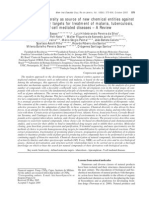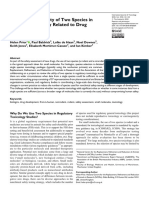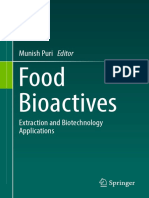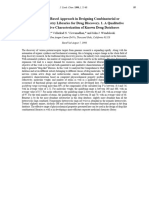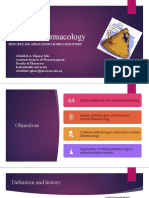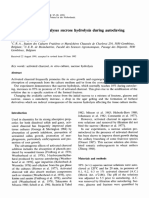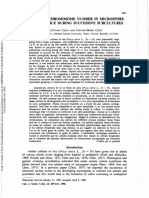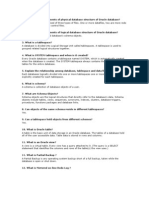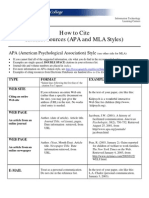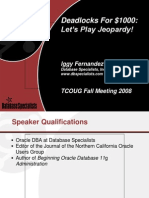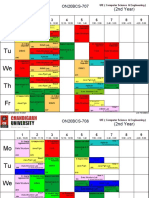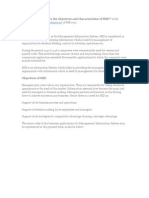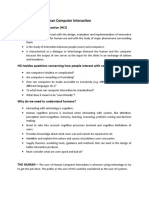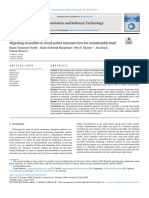Gaulton 2015
Gaulton 2015
Uploaded by
László SágiCopyright:
Available Formats
Gaulton 2015
Gaulton 2015
Uploaded by
László SágiOriginal Title
Copyright
Available Formats
Share this document
Did you find this document useful?
Is this content inappropriate?
Copyright:
Available Formats
Gaulton 2015
Gaulton 2015
Uploaded by
László SágiCopyright:
Available Formats
www.nature.
com/scientificdata
OPEN A large-scale crop protection
SUBJECT CATEGORIES
» Chemical Biology bioassay data set
» Plant Sciences
Anna Gaulton1, Namrata Kale1, Gerard J.P. van Westen1,y, Louisa J. Bellis1,
» Agroecology
A. Patrícia Bento1, Mark Davies1,y, Anne Hersey1, George Papadatos1, Mark Forster2,
» Microbiology Philip Wege2 & John P. Overington1,y
ChEMBL is a large-scale drug discovery database containing bioactivity information primarily extracted
from scientific literature. Due to the medicinal chemistry focus of the journals from which data are
extracted, the data are currently of most direct value in the field of human health research. However, many
of the scientific use-cases for the current data set are equally applicable in other fields, such as crop
Received: 16 March 2015 protection research: for example, identification of chemical scaffolds active against a particular target or
Accepted: 10 June 2015 endpoint, the de-convolution of the potential targets of a phenotypic assay, or the potential targets/
Published: 07 July 2015 pathways for safety liabilities. In order to broaden the applicability of the ChEMBL database and allow
more widespread use in crop protection research, an extensive data set of bioactivity data of insecticidal,
fungicidal and herbicidal compounds and assays was collated and added to the database.
Design Type(s) data integration objective • database maintenance • digital curation
Measurement Type(s) bioactivity assay
Technology Type(s) data collection method
Factor Type(s)
Sample Characteristic(s)
1
European Molecular Biology Laboratory —European Bioinformatics Institute, Wellcome Trust Genome Campus,
Hinxton, Cambridgeshire CB10 1SD, UK. 2Syngenta, Jealott’s Hill International Research Centre, Bracknell, Berkshire
RG42 6EY, UK. yPresent addresses: Leiden Academic Centre for Drug Research, Einstein weg 55, Leiden 2333 CC,
The Netherlands (G.J.P.v.W.); Stratified Medical, 91-93 Farringdon Road, London EC1M 3LN, UK (M.D. and J.P.O.).
Correspondence and requests for materials should be addressed to A.G. (email: agaulton@ebi.ac.uk).
SCIENTIFIC DATA | 2:150032 | DOI: 10.1038/sdata.2015.32 1
www.nature.com/sdata/
Background & Summary
ChEMBL (https://www.ebi.ac.uk/chembl/) is a large-scale drug discovery database containing informa-
tion about bioactive molecules, their interaction with molecular targets and their biological effects1,2.
These data are manually extracted from full-text scientific articles in peer-reviewed medicinal chemistry
journals and include information about the compounds synthesized or tested (together with their 2D
chemical structures), the assays performed on these compounds and the molecular targets of those assays
(where known). All experimental activity measurements are captured from the articles, regardless of
whether these are binding affinity measurements against protein targets, phenotypic outcomes in whole
organism assays or measurements of pharmacokinetic or physicochemical parameters. The most recent
release of the database contains over 1.4 million compounds and 13.5 million activity data points and
therefore provides a rich resource for addressing a wide range of drug-discovery questions. Examples of
the utility of ChEMBL include investigation of rules for lead optimization, such as identification of
bioisostere replacements or activity cliffs3,4; training models for prediction of the likely targets of a
compound5,6, and subsequent use in de-convoluting phenotypic assays7; assessing druggability and drug
properties, and prioritizing targets on a genome-wide scale8,9; and as a core component of a number of
other resources and data integration platforms10,11.
While the existing ChEMBL data set has thus far mainly found applications in human health, due to
the focus of the journals from which it has been extracted, this type of data set can have similar
applicability in other areas of life science, such as crop protection research. Though many of the
chemotypes, molecular targets and species involved may differ in this field, the broad applications of a
large-scale bioactivity data set remain equally relevant. We therefore sought to supplement the data
currently in ChEMBL with a rich set of crop protection bioactivity data. A number of key journals were
identified as being of particular interest for data extraction, and a text-mining approach12 was also used to
identify additional articles within PubMed that were likely to contain herbicidal, fungicidal or insecticidal
bioactivity data. Compound structures, assay information and activity measurements were extracted from
these articles, and the extracted data were further curated to standardize chemical structures, normalize
assay descriptions and species names and identify molecular targets. Finally, in order to allow the
broadest applicability of the new data set, the information was integrated into the ChEMBL database
(version 19), allowing crop protection data to be viewed and analysed along side human health-related
information.
Methods
Content identification
Publications containing relevant data were selected in two ways. Firstly a set of documents was selected
using the ChEMBL-likeness text-mining algorithm, which has been published previously12. The
ChEMBL-likeness algorithm was trained on the ChEMBL_15 corpus and an equally sized set of random
MedLine abstracts that were not in ChEMBL. 141,252 abstracts containing crop protection-related
keywords (see Supplementary File 1) were retrieved from MedLine and scored using the algorithm.
Additional factors such as the availability of Open Access and access costs for the papers were also
considered. The top 600 articles identified by this process were kept for abstraction. Secondly, four
journals were identified as having significant crop protection content (Medicinal Chemistry Research,
Crop Protection, Pest Management Science and Journal of Agricultural and Food Chemistry). All papers
containing bioactivity data were therefore extracted from these journals.
The list of articles resulting from this selection process is shown in Supplementary Table 1.
Data extraction
Data were manually extracted from full-text of selected articles, following a set of curation guidelines, and
were supplied according to the ChEMBL deposition template (ftp://ftp.ebi.ac.uk/pub/databases/chembl/
ChEMBLNTD/ChEMBL_Deposition_Template.tar.gz). For each extracted article, full citation details
were provided, including either a PubMed ID or DOI. All reported compounds that had been tested for
activity measurements (including qualitative measurements and negative results) were drawn in full,
including any salt if present, and stored as MDL Molfiles13. Compound names as recorded in the original
articles were also extracted. All of the performed assays (including binding, functional/phenotypic,
toxicity and physicochemical property assays) were recorded with a succinct but meaningful description
of the experiment, further annotated with information on the species, strain, tissue, cell line or subcellular
fraction used, and the name and/or UniProt identifiers of targets, where known. All measurements
reported for each compound/assay were extracted together with their units and any qualifier used (e.g.,
= , >, o, o = ). Qualitative measurements (e.g., ‘Inactive’, ‘Not toxic’) were also extracted and recorded
as an activity comment.
Data standardization and curation
A purpose-built Pipeline Pilot14 protocol was used to standardize compound structures according to the
established ChEMBL business rules2, which are based on the FDA substance registration system
guidelines15. This included Kekulization of aromatic bonds; correction of incorrect valences;
standardization of nitro and sulfoxide groups, steroid stereochemistry and halide salts; protonation/
SCIENTIFIC DATA | 2:150032 | DOI: 10.1038/sdata.2015.32 2
www.nature.com/sdata/
deprotonation of acids/bases to produce neutral molecules wherever possible; and moving
stereochemistry from ring bonds onto adjacent hydrogen atoms. In addition ‘parent’ molecules were
also generated, by removing isotope and salt information, so that bioactivity data could be grouped at the
parent level whilst still recording the molecular form used in the experiment. For parent molecules a
range of properties such as ALogP, molecular weight, number of hydrogen bond donors/acceptors, polar
surface area and most acidic/basic pKa were calculated using Pipeline Pilot and ACDlabs Physchem
software16. Compounds were integrated with existing ChEMBL compounds using the Standard InChI17
to determine identity, i.e., compounds with a novel Standard InChI were registered as new compounds in
ChEMBL, while those matching an existing Standard InChI were mapped to the existing entry in the
ChEMBL molecule_dictionary. In order to generate cross-references to other compound-based resources
(e.g., PubChem18, ZINC19, ChEBI20), the extracted compounds were also incorporated in the UniChem
system21,22, as part of the ChEMBL data source.
Known pesticides were also assigned a mechanism of action classification according to the Fungicide
Resistance Action Committee (FRAC), Herbicide Resistance Action Committee (HRAC) or Insecticide
Resistance Action Committee (IRAC) systems23–25.
Assay descriptions were manually inspected to ensure accuracy and consistency of the details provided
and to check the validity of the tissue, target and species names. Species were standardized to the
taxonomy IDs and names used by the NCBI Taxonomy database26 and strain information was recorded
separately. Each assay was assigned a BioAssay Ontology assay format term (e.g., biochemical, cell-based,
tissue-based, organism-based) using a custom rule-based text classifier, based on the information
provided by the assay description, and associated assay and target fields27. Cell-lines used in assays were
also mapped to the ChEMBL cell_dictionary and to several other external ontologies: CLO28, EFO29 and
Cellosaurus30.
Protein targets were mapped to corresponding primary accessions in the UniProt database31. Where a
protein from the correct species was not available in UniProt, a close orthologue was selected and the
ChEMBL relationship_type flag was used to record this. Where bioactivity was measured against a
protein complex, the ChEMBL target recorded reflected this, and was mapped to the UniProt accessions
for each of the individual protein subunits. Where molecular targets of assays were not known, tissue- or
organism-level targets were assigned to the assay. Where the target assigned to an assay matched an
existing ChEMBL target in both species and identity (according to the sequence and/or accession for a
single protein, or sequence and/or accession of all target components for a protein complex) this target
identifier was used, otherwise a new ChEMBL target was created with the appropriate type (e.g., SINGLE
PROTEIN, PROTEIN COMPLEX, ORGANISM). The resulting entries in the ChEMBL target_dictionary
were manually checked for redundancy, and any occurrences of multiple entries for the same protein
were removed (for example many proteins have multiple UniProt entries with different sequences
recorded due to errors, variants or partial sequences). For new targets, cross-references to other protein-
based resources (e.g., Gene Ontology32, InterPro33, Pfam34) were generated from the cross-references
provided by the corresponding UniProt entries.
The species tested in the data set were manually classified according to the standard ChEMBL
organism classification system. To address the specific needs of this data set, an enhanced version of this
classification, with greater focus on plants, arthropods and fungi, was also prepared and made available
for download as an additional file. Proteins were also classified according to the ChEMBL protein family
classification system (which covers key drug-discovery relevant protein families using community-
defined and accepted classification schemes35–39).
Activity measurements were standardized according to the standard ChEMBL procedure described
previously1 to ensure that common activity types (e.g., IC50, GI50, etc.) were provided with comparable
units, and to flag potential erroneous measurements (e.g., possible transcription errors). Activity types
were also mapped to BioAssay Ontology result terms and units to Unit Ontology40 and Quantities, Units,
Dimensions and Data Types Ontologies (QUDT)41 terms.
Following curation and standardization, data were integrated into version 19 of the ChEMBL database
(released 23rd July 2014). Fig. 1 shows an overview of the data extraction and standardization process.
Data Records
A total of 2,444 publications were selected for data extraction (see Supplementary Table 1).
This yielded a data set of 40,261 compound records, 37,311 assays (see Supplementary Table 2) and
245,370 bioactivity measurements. Of the compounds that were identified, 28,109 had structures that
were not previously present in the ChEMBL database, indicating significant novelty compared with the
standard medicinal chemistry content. Due to the complete inclusion of the Medicinal Chemistry
Research journal, some extracted assays related to human health. However the vast majority of the assays
measured herbicidal, fungicidal or insecticidal activity. Fig. 2 shows the distribution of target organisms,
assay format and assay type across this data set, showing a distinct difference from the existing content of
the database, particularly with respect to the proportion of the crop protection literature that represents
organism-level phenotypic measurements rather than protein-based binding data.
Data were deposited in the ChEMBL database (version 19, released 23rd July 2014; Data Citation 1)
and are accessible via a web-interface (https://www.ebi.ac.uk/chembl/), web-services (https://www.ebi.ac.
uk/chembl/ws), and in a variety of download formats (ftp://ftp.ebi.ac.uk/pub/databases/chembl/
SCIENTIFIC DATA | 2:150032 | DOI: 10.1038/sdata.2015.32 3
www.nature.com/sdata/
Compounds
Salt removal Property calculation aLogP 0.74
HBA 2
Data extraction HBD 1
MWt 155.2
Ro5 0
RTB 2
Standardisation HAtoms 11
pKa 7.84
LogD -0.78
QED 0.55
Activities Compound registration
Assays
Compounds
Assays
Unit conversion
and error detection
Ki = LD50 =
0.045 M 10mg/kg
Target
assignment
Ontology
annotation
ChEMBL integration
Assays Molecule
dictionary
Target
registration
Target
dictionary
Activities
Figure 1. Diagram showing the data collection, standardization and integration process. Details of assays
performed, compounds tested and activity measurements were extracted from full text publications. Data were
further standardized to normalize compound structures, convert units of measurement and assign target
information, before being integrated into the ChEMBL database.
ChEMBLdb/ and ftp://ftp.ebi.ac.uk/pub/databases/chembl/ChEMBL-RDF/). Since ChEMBL and Pub-
Chem BioAssay regularly exchange data, the data set is also available via PubChem (https://www.ncbi.
nlm.nih.gov/pcassay).
Technical Validation
While all data within the set were extracted from peer-reviewed scientific publications, there is always a
possibility of errors being introduced, either by the original author or by the manual data extraction
process. For this reason, additional data curation and validation was carried out (see methods). In
particular, assay descriptions and target assignments were checked and corrected by a second curator,
and chemical structures were checked for chemistry errors (such as incorrect valence) and standardized.
An automated process was used to detect potential errors in activity values or their units. For example, an
IC50 value with units of ml would be flagged with the data_validity_comment ‘Non standard units for
type’, while a Ki value of 7.4 M would be flagged as ‘Outside typical range’.
Once released, data within ChEMBL are further checked and corrected on an ongoing basis. Therefore
any additional errors or inconsistencies detected within the crop protection data set (either following
feedback from users, or in response to our own error detection processes) will be corrected in subsequent
releases. However, the data will still remain available in its original form, as released in ChEMBL_19,
from the FTP site.
Usage Notes
The ChEMBL web interface (https://www.ebi.ac.uk/chembl/) provides a number of mechanisms for
searching and retrieval of relevant information. Target information in the database is classified both in
terms of protein family but also by species. Using the ‘Browse Targets’ tab and switching to the
‘Taxonomy Tree’ view therefore allows users to retrieve all targets (both protein and non-molecular or
SCIENTIFIC DATA | 2:150032 | DOI: 10.1038/sdata.2015.32 4
www.nature.com/sdata/
Figure 2. Comparison of crop protection and medicinal chemistry data sets. Pie charts showing a comparison
of the features of the extracted crop protection assays with existing ChEMBL data (medicinal chemistry
literature): (a) target organism distribution by number of assays, (b) assay format distribution by number of
assays, (c) assay type distribution by number of assays.
species-level targets) belonging to a particular kingdom or phylum (e.g., Viridiplantae, Arthropoda,
Fungi). Members of the resulting target list can then be selected/deselected and bioactivity data be
retrieved or filtered using a drop-down menu. Alternatively, a keyword search is available to search across
compound and target names and synonyms, assay descriptions and document titles/abstracts. Therefore
entering a search term such as ‘herbicidal’ into the search box and selecting ‘Assays’ will retrieve a list of
all assay descriptions containing this keyword. The ChEMBL document identifiers listed in
Supplementary Table 1 can also be entered into this search field in order to return all data associated
with that document. Finally, users can retrieve compounds similar to a structure of interest (e.g., a known
pesticide) using the ‘Ligand Search’ tab, which provides identity, substructure and similarity searching
functionality. Further details of the ChEMBL interface and its functionality are provided in previous
publications1,2 and on the FAQ page (https://www.ebi.ac.uk/chembl/faq).
While the web interface provides the basic functionality to interrogate the data relating to a particular
compound, target or species of interest, users wishing to perform large-scale data retrieval or analysis may
SCIENTIFIC DATA | 2:150032 | DOI: 10.1038/sdata.2015.32 5
www.nature.com/sdata/
wish to instead use the ChEMBL web services or download a version of the database for local installation.
The ChEMBL web services homepage (https://www.ebi.ac.uk/chembl/ws) provides information on the
web service calls available and an example Python client. Similarly, schema documentation (including a
schema diagram) is provided alongside the various download formats on the FTP site, and example SQL
queries are provided on the ChEMBL FAQ page. Both the ChEMBL interface and web services are
provided over a secure HTTPS connection. Alternatively, a local installation of the myChEMBL virtual
machine provides local access to the full ChEMBL database along with a plethora of computational tools
and examples for data analysis42. Other open-source tools such as Open Babel43 or RDKit44 can also be
used to compare and analyze compound structures, using the structure-data file provided on the FTP site.
Users should always be aware that although data are extracted manually and further curated, some
errors are inevitable in such a large data set and therefore data should always be treated with caution. For
example, upon identifying an interesting activity data point for a compound or target of interest, it is
always prudent to consult the original publication to ascertain further details of the experimental
procedures before using the data as the basis for further experiments. Similarly, for large-scale
applications such as the construction of target prediction models, it is advisable to carefully filter the data
to remove potential duplicates or erroneous values (for example using the data_validity_comments)45
and to pay attention to the details of the assigned target. For example, the target type of ‘PROTEIN
FAMILY’ usually denotes a non-subtype specific assay and may not be appropriate for inclusion,
similarly the relationship_type flag indicates whether the target mapped is the exact target used in
the assay.
References
1. Bento, A. P. et al. The ChEMBL bioactivity database: an update. Nucleic Acids Res. 42, D1083–D1090 (2014).
2. Gaulton, A. et al. ChEMBL: a large-scale bioactivity database for drug discovery. Nucleic Acids Res. 40, D1100–D1107 (2012).
3. Besnard, J. et al. Automated design of ligands to polypharmacological profiles. Nature 492, 215–220 (2012).
4. Dimova, D., Stumpfe, D. & Bajorath, J. Systematic assessment of coordinated activity cliffs formed by kinase inhibitors and
detailed characterization of activity cliff clusters and associated SAR information. Eur. J. Med. Chem. 90, 414–427 (2015).
5. Gfeller, D. et al. SwissTargetPrediction: a web server for target prediction of bioactive small molecules. Nucleic Acids Res. 42,
W32–W38 (2014).
6. Lounkine, E. et al. Large-scale prediction and testing of drug activity on side-effect targets. Nature 486, 361–367 (2012).
7. Martinez-Jimenez, F. et al. Target prediction for an open access set of compounds active against Mycobacterium tuberculosis.
PLoS Comput. Biol. 9, e1003253 (2013).
8. Magarinos, M. P. et al. TDR Targets: a chemogenomics resource for neglected diseases. Nucleic Acids Res. 40,
D1118–D1127 (2012).
9. van Westen, G. J., Gaulton, A. & Overington, J. P. Chemical, target, and bioactive properties of allosteric modulation. PLoS
Comput. Biol. 10, e1003559 (2014).
10. Williams, A. J. et al. Open PHACTS: semantic interoperability for drug discovery. Drug Discov. Today 17, 1188–1198 (2012).
11. Bulusu, K. C., Tym, J. E., Coker, E. A., Schierz, A. C. & Al-Lazikani, B. canSAR: updated cancer research and drug discovery
knowledgebase. Nucleic Acids Res. 42, D1040–D1047 (2014).
12. Papadatos, G. et al. A document classifier for medicinal chemistry publications trained on the ChEMBL corpus. J. Cheminform. 6,
40 (2014).
13. Dalby, A. et al. Description of several chemical structure file formats used by computer programs developed at Molecular Design
Limited. J. Chem. Inf. Comput. Sci. 32, 244–255 (1992).
14. Pipeline Pilot v. 8.5 (Accelrys Inc, 2012).
15. Food and Drug Administration, Food and Drug Administration Substance Registration System Standard Operating Proceedure
Version 5c, http://www.fda.gov/downloads/ForIndustry/DataStandards/SubstanceRegistrationSystem-UniqueIn-
gredientIdentifierUNII/ucm127743.pdf (2007).
16. ACDLabs Physchem software v. 12.01 (Advanced Chemistry Development Inc, 2010).
17. Heller, S., McNaught, A., Stein, S., Tchekhovskoi, D. & Pletnev, I. InChI—the worldwide chemical structure identifier standard. J.
Cheminform. 5, 7 (2013).
18. Wang, Y. et al. PubChem BioAssay: 2014 update. Nucleic Acids Res. 42, D1075–D1082 (2014).
19. Irwin, J. J., Sterling, T., Mysinger, M. M., Bolstad, E. S. & Coleman, R. G. ZINC: a free tool to discover chemistry for biology. J.
Chem. Inf. Model. 52, 1757–1768 (2012).
20. Hastings, J. et al. The ChEBI reference database and ontology for biologically relevant chemistry: enhancements for 2013. Nucleic
Acids Res. 41, D456–D463 (2013).
21. Chambers, J. et al. UniChem: extension of InChI-based compound mapping to salt, connectivity and stereochemistry layers. J.
Cheminform. 6, 43 (2014).
22. Chambers, J. et al. UniChem: a unified chemical structure cross-referencing and identifier tracking system. J. Cheminform. 5,
3 (2013).
23. Fungicide Resistance Action Committee. FRAC Code List 2014, http://www.frac.info/docs/default-source/publications/frac-code-
list/frac-code-list-2015-finalC2AD7AA36764.pdf?sfvrsn=4 FRAC Code List.pdf (2014).
24. Herbicide Resistance Action Committee. HRAC Classification of Herbicides According to Site of Action, http://www.hracglobal.
com/pages/classificationofherbicidesiteofaction.aspx (2014).
25. Insecticide Resistance Action Committee. IRAC Mode of Action Classification Brochure, http://www.irac-online.org/documents/
moa-brochure/?ext = pdf (2014).
26. Federhen, S. The NCBI Taxonomy database. Nucleic Acids Res. 40, D136–D143 (2012).
27. Visser, U. et al. BioAssay Ontology (BAO): a semantic description of bioassays and high-throughput screening results. BMC
Bioinformatics 12, 257 (2011).
28. Sarntivijai, S, X. Z. et al. Cell Line Ontology: redesigning cell line knowledgebase to aid integrative translational informatics.
Proceedings of the International Conference on Biomedical Ontology (ICBO) 2011, 25–32 (2011).
29. Malone, J. et al. Modeling sample variables with an Experimental Factor Ontology. Bioinformatics 26, 1112–1118 (2010).
30. Calipo group at Swiss Institute for Bioinformatics. Cellosaurus: a controlled vocabulary of cell lines, ftp://ftp.nextprot.org/pub/
current_release/controlled_vocabularies/cellosaurus.txt (2013).
31. UniProt Consortium. UniProt: a hub for protein information. Nucleic Acids Res. 43, D204–D212 (2015).
32. Gene Ontology Consortium. Gene Ontology Consortium: going forward. Nucleic Acids Res. 43, D1049–D1056 (2015).
SCIENTIFIC DATA | 2:150032 | DOI: 10.1038/sdata.2015.32 6
www.nature.com/sdata/
33. Mitchell, A. et al. The InterPro protein families database: the classification resource after 15 years. Nucleic Acids Res. 43,
D213–2213 (2015).
34. Finn, R. D. et al. Pfam: the protein families database. Nucleic Acids Res. 42, D222–D230 (2014).
35. Pawson, A. J. et al. The IUPHAR/BPS Guide to PHARMACOLOGY: an expert-driven knowledgebase of drug targets and their
ligands. Nucleic Acids Res. 42, D1098–D1106 (2014).
36. Manning, G., Whyte, D. B., Martinez, R., Hunter, T. & Sudarsanam, S. The protein kinase complement of the human genome.
Science 298, 1912–1934 (2002).
37. Rawlings, N. D., Waller, M., Barrett, A. J. & Bateman, A. MEROPS: the database of proteolytic enzymes, their substrates and
inhibitors. Nucleic Acids Res. 42, D503–D509 (2014).
38. Nuclear Receptors Nomenclature, C. A unified nomenclature system for the nuclear receptor superfamily. Cell 97,
161–163 (1999).
39. Liu, L., Zhen, X. T., Denton, E., Marsden, B. D. & Schapira, M. ChromoHub: a data hub for navigators of chromatin-mediated
signalling. Bioinformatics 28, 2205–2206 (2012).
40. Gkoutos, G. V., Schofield, P. N. & Hoehndorf, R. The Units Ontology: a tool for integrating units of measurement in science.
Database 2012, bas033 (2012).
41. Hodgson, R., Keller, P. J., Hodges, J. & Spivak, J. QUDT—Quantities, Units, Dimensions and Data Types Ontology, http://www.
qudt.org (2014).
42. Ochoa, R., Davies, M., Papadatos, G., Atkinson, F. & Overington, J. P. myChEMBL: a virtual machine implementation of open
data and cheminformatics tools. Bioinformatics 30, 298–300 (2014).
43. O'Boyle, N. M. et al. Open Babel: An open chemical toolbox. J. Cheminform 3, 33 (2011).
44. RDKit: Open-source cheminformatics, http://www.rdkit.org (2015).
45. Kramer, C., Kalliokoski, T., Gedeck, P. & Vulpetti, A. The experimental uncertainty of heterogeneous public K(i) data. J. Med.
Chem. 55, 5165–5173 (2012).
Data Citation
1. Gaulton, A. et al. ChEMBL, http://dx.doi.org/10.6019/CHEMBL.database.19 (2014).
Acknowledgements
The authors would like to acknowledge the additional contributions of Jon Chambers and Michal
Nowotka in the inclusion of this data in ChEMBL. Funding for this work was provided by Syngenta,
Wellcome Trust (Strategic Award: WT086151/Z/08/Z) and European Molecular Biology Laboratory.
Author Contributions
AG quality-controlled the extracted data, integrated with ChEMBL and assigned target and taxonomy
information. NK curated the assay data and assigned target information. GJPvW developed, optimized
and validated the chembl-likeness algorithm and identified relevant articles for inclusion. LJB developed
the compound standardization procedure and curated the compounds. APB assigned the modes of action
for known pesticides. MD provided a testing environment, made interface enhancements and developed
the RDF download format. AH prioritized articles for inclusion, calculated compound properties and
developed bioactivity data standardization rules. GP developed, optimized and validated the chembl-
likeness algorithm and developed the bioactivity data validation procedure. MF conceived the work,
coordinated the project and led internal exploitation of the data. PW conceived the work and prioritized
journals for full data extraction. JPO planned and directed the work.
Additional Information
Supplementary information accompanies this paper at http://www.nature.com/sdata
Competing financial interests: Syngenta is a commercial organization involved in crop protection
research and development.
How to cite this article: Gaulton, A. et al. A large-scale crop protection bioassay data set. Sci. Data
2:150032 doi: 10.1038/sdata.2015.32 (2015).
This work is licensed under a Creative Commons Attribution 4.0 International License. The
images or other third party material in this article are included in the article’s Creative
Commons license, unless indicated otherwise in the credit line; if the material is not included under the
Creative Commons license, users will need to obtain permission from the license holder to reproduce the
material. To view a copy of this license, visit http://creativecommons.org/licenses/by/4.0
Metadata associated with this Data Descriptor is available at http://www.nature.com/sdata/ and is released
under the CC0 waiver to maximize reuse.
SCIENTIFIC DATA | 2:150032 | DOI: 10.1038/sdata.2015.32 7
You might also like
- DatabaseDocument10 pagesDatabaseDAYANGKU SYAIDATUL FARHANA BINTI AWANGKU ABDUL RAZAK BF21110191No ratings yet
- Chemoinformatics and drug discoveryDocument12 pagesChemoinformatics and drug discoveryNandini KotharkarNo ratings yet
- Prediction of Drug Target Based On SequenceDocument11 pagesPrediction of Drug Target Based On SequenceGunjan SharmaNo ratings yet
- Baac 047Document21 pagesBaac 047mariokhalilhabeeb87No ratings yet
- NACB LMPG Use of Tumor Markers in Clinical Practice Quality Requirements 2017Document17 pagesNACB LMPG Use of Tumor Markers in Clinical Practice Quality Requirements 2017yamgfbNo ratings yet
- separations-11-00205Document29 pagesseparations-11-00205maizhafiraNo ratings yet
- BiometryDocument28 pagesBiometryCollins MuseraNo ratings yet
- UNIT - IV BioinformticsDocument14 pagesUNIT - IV BioinformticsDhaval Telang100% (1)
- CHAP 12 - Bioinformatics - Research ApplicationDocument8 pagesCHAP 12 - Bioinformatics - Research ApplicationTrucanh DaoNo ratings yet
- 07 - 18 - Recent Applications of Deep Learning and MachineDocument35 pages07 - 18 - Recent Applications of Deep Learning and Machinedeepa yagantiNo ratings yet
- Artificial Intelligence For Natural Product Drug DiscoveryDocument22 pagesArtificial Intelligence For Natural Product Drug DiscoveryKarthik ManguNo ratings yet
- (Methods in Molecular Biology 2194) Joseph Markowitz - Translational Bioinformatics For Therapeutic Development-Springer US - Humana (2021)Document323 pages(Methods in Molecular Biology 2194) Joseph Markowitz - Translational Bioinformatics For Therapeutic Development-Springer US - Humana (2021)Guilherme Jung100% (1)
- Anish Nag Nikhil Dhull Ashmita Gupta: Original ArticleDocument23 pagesAnish Nag Nikhil Dhull Ashmita Gupta: Original ArticleFajri FebrianNo ratings yet
- Msczo 603Document141 pagesMsczo 603DevanshiNo ratings yet
- 2020 - Justification For Species Selection For Pharmaceutical Toxicity StudiesDocument13 pages2020 - Justification For Species Selection For Pharmaceutical Toxicity StudiesMicaelaNo ratings yet
- Biochemometrics and Required Tools in Botanical Natural Products Research A ReviewDocument17 pagesBiochemometrics and Required Tools in Botanical Natural Products Research A ReviewKevin WyssNo ratings yet
- Molecules: NMR-Based Plant Metabolomics in Nutraceutical Research: An OverviewDocument22 pagesMolecules: NMR-Based Plant Metabolomics in Nutraceutical Research: An Overviewalanbecker_alNo ratings yet
- Novi Modusi LečenjaDocument32 pagesNovi Modusi LečenjaDivna CvetkovićNo ratings yet
- 4 Pages HCMPHDocument4 pages4 Pages HCMPHLuciaNo ratings yet
- Bremner 2009Document11 pagesBremner 2009yosraNo ratings yet
- "If You Can't Do Bioinformatics, You Can't Do Biology", J.D. Tisdall, 2003Document12 pages"If You Can't Do Bioinformatics, You Can't Do Biology", J.D. Tisdall, 2003ithaldheerajNo ratings yet
- Metabolic Identification Untargeted-Metabolomics Metabolomics 2012Document23 pagesMetabolic Identification Untargeted-Metabolomics Metabolomics 2012Ummu Mastna ZuhriNo ratings yet
- In Silico Pharmacology For Drug Discovery: Methods For Virtual Ligand Screening and ProfilingDocument12 pagesIn Silico Pharmacology For Drug Discovery: Methods For Virtual Ligand Screening and ProfilingDwi PuspitaNo ratings yet
- PeptidesDocument21 pagesPeptidespaulo saNo ratings yet
- Preclinical Drug Discovery and Development: David S. DuchDocument26 pagesPreclinical Drug Discovery and Development: David S. DuchAkanksha PatelNo ratings yet
- Question Bank (Bioinformatics I)Document75 pagesQuestion Bank (Bioinformatics I)bhawana.thakkar.bt.2021No ratings yet
- CHEMOINFORMATICSDocument13 pagesCHEMOINFORMATICSPiyushNo ratings yet
- Metabolic Profiling of CHO Cells During The Production of BiotherapeuticsDocument21 pagesMetabolic Profiling of CHO Cells During The Production of Biotherapeuticsip87JCNo ratings yet
- Biotechnology Advances: Research Review PaperDocument27 pagesBiotechnology Advances: Research Review PaperCJ ZafraNo ratings yet
- Computational ImmunologyDocument8 pagesComputational Immunologybiosaran2004No ratings yet
- Bmir 2001 0898Document22 pagesBmir 2001 0898selena minchalaNo ratings yet
- Meta AnalysisDocument7 pagesMeta AnalysissamanNo ratings yet
- Drug Discovery Complete NotesDocument5 pagesDrug Discovery Complete NotesSadiqa ForensicNo ratings yet
- What Is BioinformaticsDocument30 pagesWhat Is BioinformaticsnaveenbioinformaticsNo ratings yet
- Analitical ChemistryDocument4 pagesAnalitical ChemistryIsraleah LedesmaNo ratings yet
- Metabolites: The Metarbolomics Toolbox in Bioconductor and BeyondDocument55 pagesMetabolites: The Metarbolomics Toolbox in Bioconductor and BeyondIgnacio Pérez-VictoriaNo ratings yet
- Bio AssayDocument19 pagesBio AssayMansi BelaniNo ratings yet
- Unique Aspects of The Design of Phase I-II Clinical Trials of Stem Cell Therapy (2018)Document29 pagesUnique Aspects of The Design of Phase I-II Clinical Trials of Stem Cell Therapy (2018)Chi-Hsiang ChenNo ratings yet
- Interactive and Comprehensive Database For Environmental Effect Data For PharmaceuticalsDocument5 pagesInteractive and Comprehensive Database For Environmental Effect Data For PharmaceuticalsRaluca RatiuNo ratings yet
- Plants 11 03243Document28 pagesPlants 11 03243Rina HerowatiNo ratings yet
- Systems Biology in Drug Discovery PDFDocument7 pagesSystems Biology in Drug Discovery PDFSakshi IssarNo ratings yet
- 2018 - Reviewing The Utility of Two Species in General Toxicology Related To Drug DevelopmentDocument4 pages2018 - Reviewing The Utility of Two Species in General Toxicology Related To Drug DevelopmentMicaelaNo ratings yet
- Aguilera Mendonza2015Document7 pagesAguilera Mendonza2015Victor MunhozNo ratings yet
- Munish Puri (Eds.) - Food Bioactives - Extraction and Biotechnology Applications (2017, Springer International Publishing) PDFDocument329 pagesMunish Puri (Eds.) - Food Bioactives - Extraction and Biotechnology Applications (2017, Springer International Publishing) PDFCarlos Sopán Benaute100% (2)
- Metagenomic Data Analysis 1071630717 9781071630716 CompressDocument443 pagesMetagenomic Data Analysis 1071630717 9781071630716 CompressJingjing BaiNo ratings yet
- Livestock MetabolomicsDocument26 pagesLivestock MetabolomicsIonela HoteaNo ratings yet
- Ghose 1999Document18 pagesGhose 1999taoufik akabliNo ratings yet
- Mass Spectrometry Based Metabolomics A Guide For Annotation, Quantification and Best ReportingDocument10 pagesMass Spectrometry Based Metabolomics A Guide For Annotation, Quantification and Best ReportingsridharNo ratings yet
- 04 Computer Applications in Pharmacy Full Unit IVDocument14 pages04 Computer Applications in Pharmacy Full Unit IVSinh LuyenNo ratings yet
- Thermosensitive Hydrogels As Drug Carriers For Breast Cancer Treatment: A Systematic ReviewDocument10 pagesThermosensitive Hydrogels As Drug Carriers For Breast Cancer Treatment: A Systematic ReviewIJPHSNo ratings yet
- Jurnal EpidDocument4 pagesJurnal EpidPascara FajarNo ratings yet
- Bioinformatics in Drug DiscoveryDocument8 pagesBioinformatics in Drug DiscoveryPrincess AleenaNo ratings yet
- Application of Bioinformatics in Various Fields: Ravi KapoparaDocument43 pagesApplication of Bioinformatics in Various Fields: Ravi KapoparasrashmiyadavNo ratings yet
- Evidence-Based Absorption, Distribution, Metabolism, Excretion (ADME) and Its Interplay With Alternative Toxicity MethodsDocument16 pagesEvidence-Based Absorption, Distribution, Metabolism, Excretion (ADME) and Its Interplay With Alternative Toxicity MethodsAyi Yurike Tri YantiNo ratings yet
- Biometry PDFDocument28 pagesBiometry PDFDrAmit VermaNo ratings yet
- Nursing Research Resources 72Document34 pagesNursing Research Resources 72willan23No ratings yet
- Role of Bioinformatics in BiotechnologyDocument5 pagesRole of Bioinformatics in BiotechnologyPriyanka VijayvargiyaNo ratings yet
- Bioinformatic Driven Search For Metabolic Biomarkers in DiseasesDocument10 pagesBioinformatic Driven Search For Metabolic Biomarkers in Diseasesdumboo21No ratings yet
- Reverse PharmacolgoyDocument55 pagesReverse Pharmacolgoyعبدالله الجزارNo ratings yet
- Endophyte Biotechnology: Potential for Agriculture and PharmacologyFrom EverandEndophyte Biotechnology: Potential for Agriculture and PharmacologyAlexander SchoutenNo ratings yet
- SterikonDocument4 pagesSterikonLászló SágiNo ratings yet
- Compton 1994Document26 pagesCompton 1994László SágiNo ratings yet
- Skirvin 1986Document3 pagesSkirvin 1986László SágiNo ratings yet
- Plastics Sterilization Compatibility ChartDocument2 pagesPlastics Sterilization Compatibility ChartLászló SágiNo ratings yet
- 15 Minute Beginner Stretching Routine (Tom Merrick)Document4 pages15 Minute Beginner Stretching Routine (Tom Merrick)László SágiNo ratings yet
- What Every Engineering Manager Wants You To Know (2017)Document286 pagesWhat Every Engineering Manager Wants You To Know (2017)László SágiNo ratings yet
- Druart 1993Document3 pagesDruart 1993László SágiNo ratings yet
- Rawson 2011Document14 pagesRawson 2011László SágiNo ratings yet
- Srivastava 2018Document25 pagesSrivastava 2018László SágiNo ratings yet
- Agargel PropertiesDocument3 pagesAgargel PropertiesLászló SágiNo ratings yet
- Sawilowsky 2002Document13 pagesSawilowsky 2002László SágiNo ratings yet
- Chen 1980 BDocument8 pagesChen 1980 BLászló SágiNo ratings yet
- Glenn 2013Document17 pagesGlenn 2013László SágiNo ratings yet
- Zargar 2022Document21 pagesZargar 2022László SágiNo ratings yet
- Wenzel 1975Document5 pagesWenzel 1975László SágiNo ratings yet
- Emanuelsson 2007Document19 pagesEmanuelsson 2007László SágiNo ratings yet
- Wei 1982Document3 pagesWei 1982László SágiNo ratings yet
- Bhagwat 2012Document41 pagesBhagwat 2012László SágiNo ratings yet
- Bottanelli 2018Document7 pagesBottanelli 2018László SágiNo ratings yet
- Cramer 2019Document11 pagesCramer 2019László SágiNo ratings yet
- Khaled ThesisDocument119 pagesKhaled ThesisLászló SágiNo ratings yet
- Fassler 2011Document8 pagesFassler 2011László SágiNo ratings yet
- Fernandez Gutierrez2021Document16 pagesFernandez Gutierrez2021László SágiNo ratings yet
- Yang 2021Document11 pagesYang 2021László SágiNo ratings yet
- Dudley 2009Document7 pagesDudley 2009László SágiNo ratings yet
- Edgar 2004Document6 pagesEdgar 2004László SágiNo ratings yet
- Nejat 2017Document16 pagesNejat 2017László SágiNo ratings yet
- Bian 2018Document16 pagesBian 2018László SágiNo ratings yet
- Tang 2011Document17 pagesTang 2011László SágiNo ratings yet
- Yao 2023Document16 pagesYao 2023László SágiNo ratings yet
- Question Bank IRS All Module - OSDocument5 pagesQuestion Bank IRS All Module - OSjanhavi.chavan21No ratings yet
- Srinivas JAVADocument6 pagesSrinivas JAVAAmogh VarshneyNo ratings yet
- Applications of DWDMDocument11 pagesApplications of DWDMAbhishek BaghelNo ratings yet
- Sheikh Muhammad Mujtaba ResumeDocument2 pagesSheikh Muhammad Mujtaba ResumeDua AliNo ratings yet
- Database Management SystemDocument51 pagesDatabase Management SystemZahiD UniXNo ratings yet
- Qlik Sense Create Apps and VisualizationsDocument275 pagesQlik Sense Create Apps and VisualizationsSelim KılıçNo ratings yet
- CA - Case Study - Insurance Claims Dashboard-Design Pass 01Document43 pagesCA - Case Study - Insurance Claims Dashboard-Design Pass 01Hanin NoviaNo ratings yet
- 2014 Anthology WEB BIx Enhance Rep SkillsDocument138 pages2014 Anthology WEB BIx Enhance Rep SkillsanjuNo ratings yet
- Interview Question For Oracle DBADocument111 pagesInterview Question For Oracle DBAVimlendu Kumar100% (1)
- A Proposed Design of A Smart Bracelet Fo PDFDocument5 pagesA Proposed Design of A Smart Bracelet Fo PDFIlham GilangNo ratings yet
- ClusteringDocument36 pagesClusteringKapildev KumarNo ratings yet
- How To Cite Internet Sources in APA and MLADocument2 pagesHow To Cite Internet Sources in APA and MLAEnjoy Myself75% (4)
- PRE ORAL Baranggay Cabalabaguan Digital Barangay Management SolutionDocument28 pagesPRE ORAL Baranggay Cabalabaguan Digital Barangay Management SolutionKathrina Mae GulmaticoNo ratings yet
- SPARTA Y5 Enrollment PackagesDocument6 pagesSPARTA Y5 Enrollment PackagesJae SasakiNo ratings yet
- TIA PRO1 17 Training and Support V15.01.01 enDocument21 pagesTIA PRO1 17 Training and Support V15.01.01 enEmilio MonterichelNo ratings yet
- DeadlocksDocument20 pagesDeadlocksSathi CoolNo ratings yet
- Class TT (Virtual Mode)Document21 pagesClass TT (Virtual Mode)Satyam KumarNo ratings yet
- Larry Ellison Bob MinerDocument29 pagesLarry Ellison Bob Minermujahid nayemNo ratings yet
- 12 Step Query Tuning SQLS IG PDFDocument1 page12 Step Query Tuning SQLS IG PDFVik BadNo ratings yet
- Define MIS? What Are The Objectives and Characteristics of MIS?"Document2 pagesDefine MIS? What Are The Objectives and Characteristics of MIS?"0559018144100% (5)
- Python Microproject PDFDocument10 pagesPython Microproject PDFAniket BokeNo ratings yet
- Section 5 GROUP ASSIGNMENT IMR451Document7 pagesSection 5 GROUP ASSIGNMENT IMR451Nurul NabilahNo ratings yet
- The Museums of The FutureDocument29 pagesThe Museums of The FuturefelantemNo ratings yet
- Libary Management SystemDocument37 pagesLibary Management Systemतिमल्सिनाप्रह्लाद60% (5)
- Introduction To Human Computer InteractionDocument7 pagesIntroduction To Human Computer InteractionKito KenNo ratings yet
- School of Computer Science and Engineering: CSE2004 - Database Management Systems Lab Cycle Sheet - IDocument21 pagesSchool of Computer Science and Engineering: CSE2004 - Database Management Systems Lab Cycle Sheet - Iaashay kumar100% (2)
- Conducting The Oracle Job Interview It Manager Guide For Oracle0Document99 pagesConducting The Oracle Job Interview It Manager Guide For Oracle0tariqbashirNo ratings yet
- Multi-Label Multimodal Emotion RecognitionDocument17 pagesMulti-Label Multimodal Emotion RecognitionNexgen TechnologyNo ratings yet
- Migracion de MonolitosDocument20 pagesMigracion de MonolitosarturoNo ratings yet
- G.R.S. Mead - Echoes From The Gnosis Vol. V - Mysteries of MithraDocument101 pagesG.R.S. Mead - Echoes From The Gnosis Vol. V - Mysteries of MithraNico Ouwehand100% (1)

















